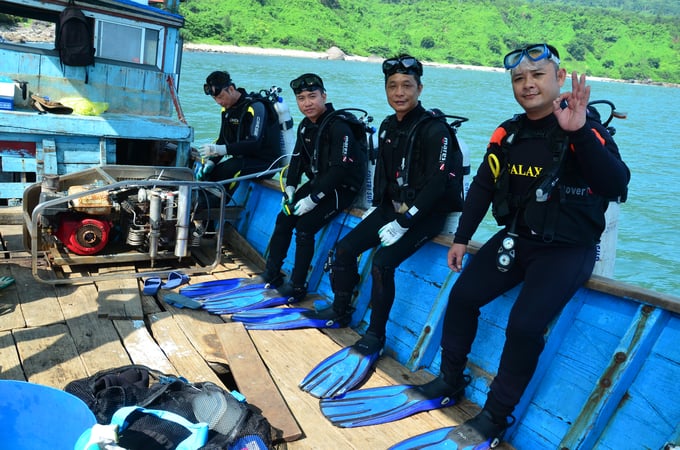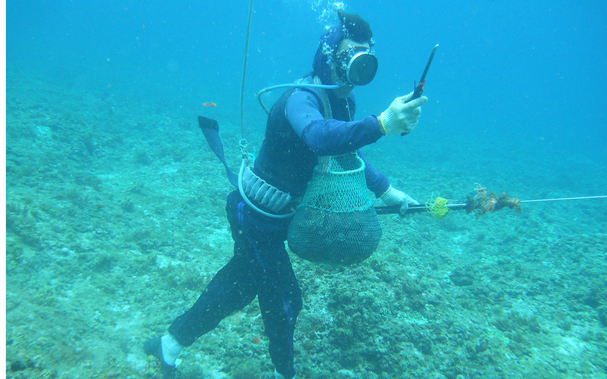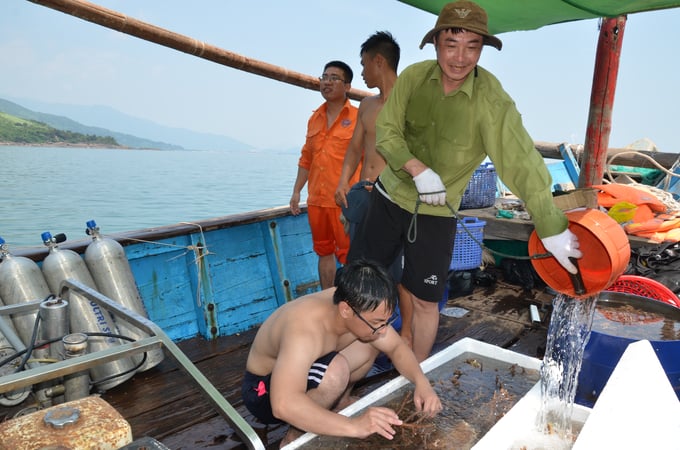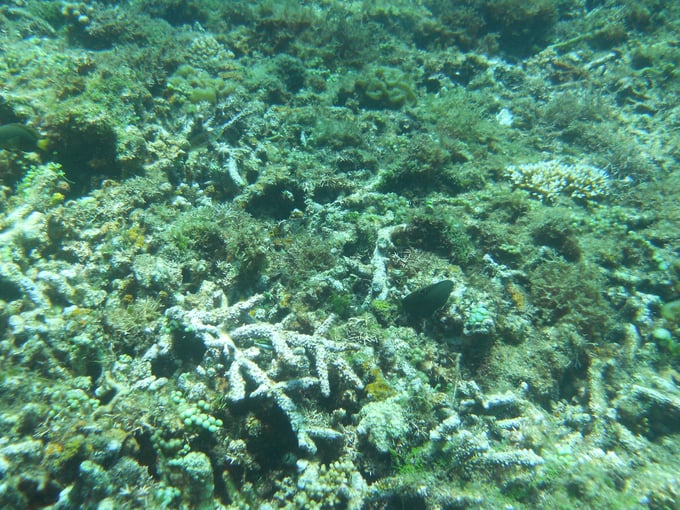November 27, 2025 | 18:05 GMT +7
November 27, 2025 | 18:05 GMT +7
Hotline: 0913.378.918
November 27, 2025 | 18:05 GMT +7
Hotline: 0913.378.918

A team of scientists from the Research Institute for Marine Fisheries prepares to dive into the sea. Photo: Duong Dinh Tuong.
The delegation of the Research Institute for Marine Fisheries on the topic "Building a technical process for culturing hard corals in Vietnamese waters" led by Master Nguyen Van Hieu worked for 4 days in the area of Hai Van - Son Cha, Thua Thien - Hue province.
Nguyen Quang Dung, the youngest trainee member of the group, pulled the cord to start the compressor that pumped air into the tank and, at the same time, prepared the substrate for coral transplantation with stainless steel mesh strips. The boat waits only for Bai Ca. It takes about 15 minutes to get there.
While the scientists dived into the sea with hammers, chisels, and plastic baskets to separate the seeds and serve to transplant corals, Le Van Tho - the owner of the largest boat in Lang Co town, Phu Loc district, recalled events in the period 1982-1992.

Le Van Tho shows off his newly caught fish. Photo: Cong Dien.
At that time, the means of fishing were outdated, and for many objective reasons, people were hungry and had to cross the border. They crowded into basket boats, surrendering their lives to God. 10 people went, and 7-8 people left the body in the sea.
Then there was the pollution of the Formosa steel factory in 2016, with dead fish floating in the sea, bringing the stench up to several hundred meters away. Mr. Tho and his wife had to quit their job to go to the sea and Hai Van Pass to sell water to feed their 5 children. More than a year later, sporadic fish appeared, and his family returned to fishing.
Growing up in the sea, Tho was as tough as a bronze statue. His back caught the sun, so scorched that when he finished scuba diving, it was as black as a blackboard, able to absorb the sweat and salt deposited on it to write words. Catching baby lobsters, launching fish spears, and cuttlefish, he dives without a gas tube.

A diver is catching snails in the sea. The bottom is almost bare with nothing. Photo: Research Institute for Marine Fisheries.
According to Mr. Tho, Formosa is just a drop of water, but before that, the sea was already exhausted. He said: "More than 10 years ago, when I dived into the sea on Ca beach, I saw corals growing thick and tall like a forest, and then they kept dying, from light green to white, finally brown and melted. All kinds of destructive fishing, such as electric pulses, explosives, and cyanide poisons, affect the environment."
After the Formosa incident, only about 10% of corals remained and less than 20% of aquatic products. Mr. Tho's family had to sell most of their fishing equipment because there was nothing left to exploit, losing up to 70%. In the past, in the area of Bai Chuoi, Mr. Tho also met dolphins and even once saw a whale more than 10m long. But two years ago, that didn't happen anymore.

The caught corals are continuously watered. Photo: Duong Dinh Tuong.
Mr. Tho has repeatedly dived under Bai Ca to realize the degradation of coral reefs. At Bai Ca, after the coral culture medium was fixed on the seabed, scientists exploited a part of the coral in situ to test the stability of the substrate. Then, they divided the coral and transplanted it by cutting branches and trees on the shore.
Usually, corals that grow in the form of spreading or being broken by waves are also a form of seeding, but they are difficult to attach to the sea floor, so they are easy to die. To help corals cling to the sea, people support them with supports that help them fix their bodies on the seabed.

Cu Lao Cham in Quang Nam province in 2011 still has many corals. Photo: Research Institute for Marine Fisheries.
Unlike in freshwater, saltwater animals that leave the sea bed will quickly die, even if they are re-released in salt water. Therefore, scientists must constantly change the water, create a flow or aerate oxygen. The coral will die almost immediately after sun exposure because the symbiotic algae are left out. Therefore, they must be kept in a shady place.
Research by the Research Institute for Marine Fisheries shows that the total area of coral reefs in Vietnam's coastal waters is estimated at 13,426 hectares. In which, the areas with the largest coral reef area include Phu Quy Island (1,858 ha), Ly Son (1,704 ha), Van Phong Bay (1,618 ha), and the coastal area of Ninh Hai - Ninh Thuan (2,330 ha).

Many sea areas are now degraded coral. Photo: Research Institute for Marine Fisheries.
There are also more minor distribution points such as Hon Mat, Nghi Son, Hon La, Dao Tran, Ba Mun, Cat Ba, Ky Loi - Vung Ang in the Gulf of Tonkin, the locations of Hon Cau, Tuy An, Ghenh Rang - Nhon Hai belong to the Central Coast and Hai Tac Island belongs to the Southwest Sea.
Studies from 1982-2004 have identified more than 400 species of 79 hard corals in the coastal areas of Vietnam. This statistical result shows that the diversity and richness of corals in species composition in the southern seas is almost equivalent to that of the coral-rich regions of the world.
Hard coral cover is considered by the global coral monitoring organization (Reefcheck) as a measure of coral reef health. The change in coverage is often related to the problems of over-exploitation, mines, and poisons.
Bucke's research in 2002 in nearly 200 coral reef sites in coastal Vietnam shows that the current coverage is not good. Only about 1% of the reefs have high coverage, while the number of reefs with low coverage accounts for over 31%. The number of reefs with average and fair coverage is above 41% and 26%. Statistical data also show reefs far from shore or populated areas remain in better condition than near the coast.
Translated by Ha Phuc
/2025/11/27/4910-4-164708_294.jpg)
(VAN) On the afternoon of November 27 in Beijing, Minister of Agriculture and Environment Tran Duc Thang held a working session with several major Chinese enterprises operating in the agriculture and environment sector.

(VAN) The Department of Animal Health issued a provisional guideline requesting local authorities to increase surveillance, collect samples for testing, and conduct epidemiological investigations according to the established procedure.

(VAN) The United Nations recommends that Vietnam utilize data and artificial intelligence to enhance early disaster warnings and reduce GDP losses by 3.2% in the context of climate change.

(VAN) On the morning of November 27 in Beijing, Minister Tran Duc Thang and the Deputy Commissioner General of the General Administration of Customs of China signed a protocol on fresh jackfruit exports.

(VAN) As floodwaters recede, a vast network of irrigation works across eastern Gia Lai is emerging in a state of severe disrepair, with extensive damage demanding urgent restoration ahead of the 2025-2026 winter-spring cropping season.

(VAN) The conference reviewing three years of implementing Decision 911 identified the need to prioritize improving marine environmental quality and promoting sustainable fisheries development.

(VAN) Le Hoai Trung, Member of the Communist Party of Viet Nam Central Committee and Minister of Foreign Affairs, held talks with Vi Thao, Chairman of the Guangxi Zhuang Autonomous Region (China) this week.